Case Study: IKEA's Global Sourcing Challenge and Child Labor Issues
VerifiedAdded on 2023/06/04
|17
|4094
|462
Case Study
AI Summary
This case study analyzes IKEA's global sourcing challenges, specifically focusing on the issue of child labor in the Indian rug industry. It examines IKEA's growth, supplier relationships, and organizational values, highlighting the key problems faced by the company, particularly the use of child labor by its suppliers. The analysis explores various options for addressing the issue, including immediate public relations strategies, dealing with suppliers like Rangan Exports, and the overall approach IKEA should take. The case also delves into the problem of child labor in India, the importance of stakeholder analysis, and the implementation of effective solutions. The study emphasizes the need for strict supplier policies, transparency, and collaboration with organizations to ensure ethical and sustainable sourcing practices. The case study offers recommendations for IKEA to navigate these challenges, maintain its brand image, and fulfill its social responsibilities.
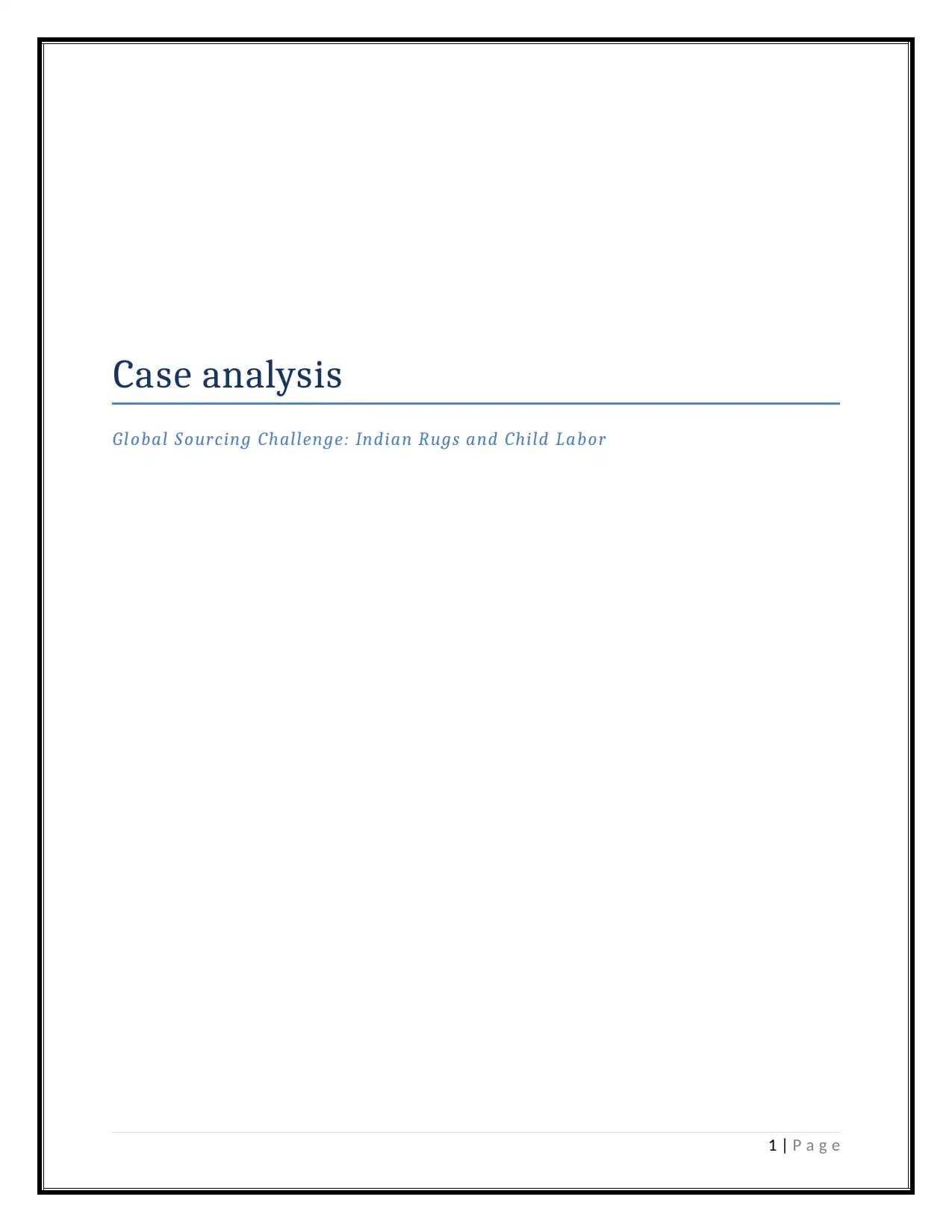
Case analysis
Global Sourcing Challenge: Indian Rugs and Child Labor
1 | P a g e
Global Sourcing Challenge: Indian Rugs and Child Labor
1 | P a g e
Paraphrase This Document
Need a fresh take? Get an instant paraphrase of this document with our AI Paraphraser
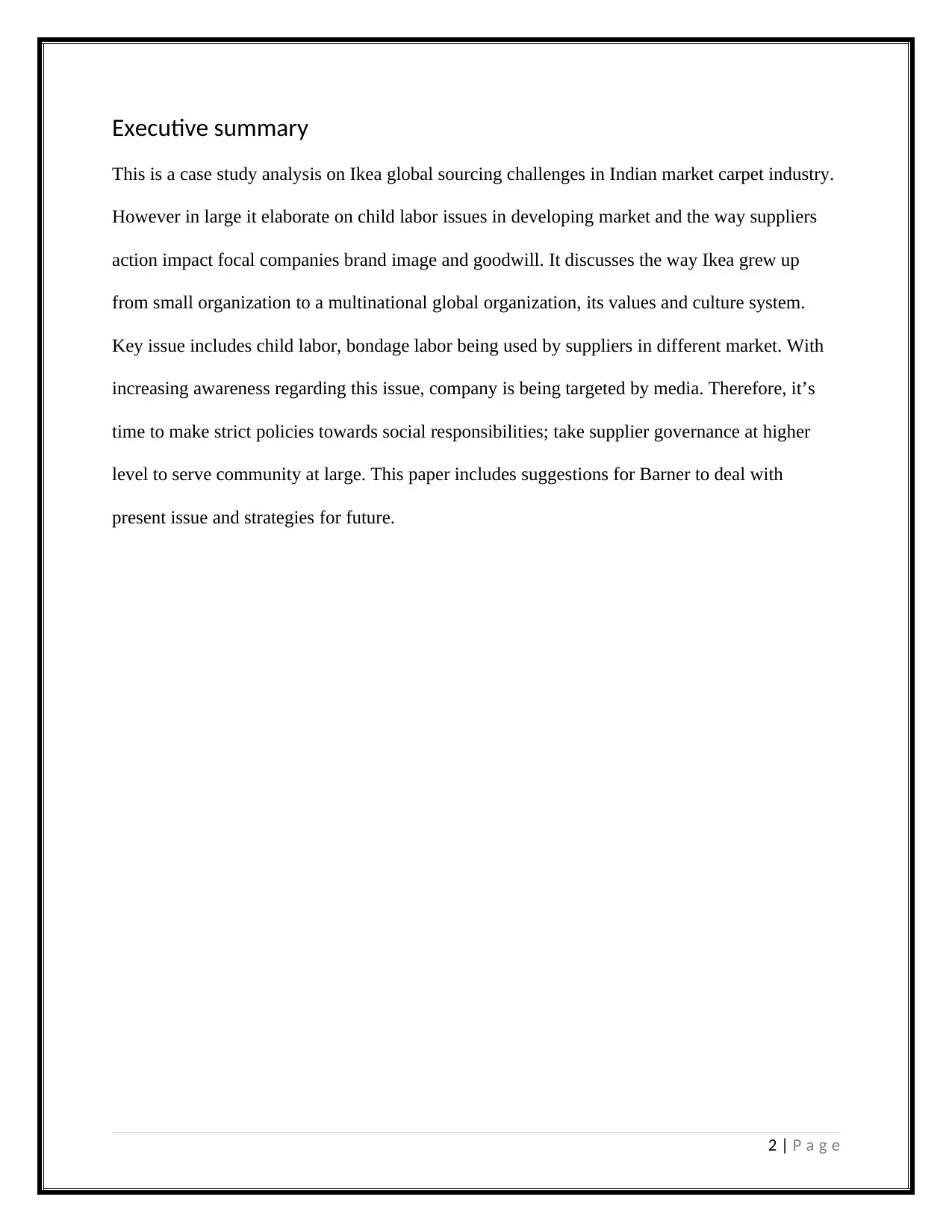
Executive summary
This is a case study analysis on Ikea global sourcing challenges in Indian market carpet industry.
However in large it elaborate on child labor issues in developing market and the way suppliers
action impact focal companies brand image and goodwill. It discusses the way Ikea grew up
from small organization to a multinational global organization, its values and culture system.
Key issue includes child labor, bondage labor being used by suppliers in different market. With
increasing awareness regarding this issue, company is being targeted by media. Therefore, it’s
time to make strict policies towards social responsibilities; take supplier governance at higher
level to serve community at large. This paper includes suggestions for Barner to deal with
present issue and strategies for future.
2 | P a g e
This is a case study analysis on Ikea global sourcing challenges in Indian market carpet industry.
However in large it elaborate on child labor issues in developing market and the way suppliers
action impact focal companies brand image and goodwill. It discusses the way Ikea grew up
from small organization to a multinational global organization, its values and culture system.
Key issue includes child labor, bondage labor being used by suppliers in different market. With
increasing awareness regarding this issue, company is being targeted by media. Therefore, it’s
time to make strict policies towards social responsibilities; take supplier governance at higher
level to serve community at large. This paper includes suggestions for Barner to deal with
present issue and strategies for future.
2 | P a g e

Table of Contents
Introduction.................................................................5
Company overview...................................................5
Strong supplier relationship management...............6
Organization culture and values...............................7
Key problems...............................................................8
Options evaluation.....................................................13
Immediate public issues.........................................17
Dealing with Rangan export...................................18
Overall approach Ikea should take.........................21
Company should deal along or allow Rugmark to monitor the case 24
Problem of child labor in India...............................27
Implementation plan..................................................31
Conclusion..................................................................34
Bibliography...............................................................36
3 | P a g e
Introduction.................................................................5
Company overview...................................................5
Strong supplier relationship management...............6
Organization culture and values...............................7
Key problems...............................................................8
Options evaluation.....................................................13
Immediate public issues.........................................17
Dealing with Rangan export...................................18
Overall approach Ikea should take.........................21
Company should deal along or allow Rugmark to monitor the case 24
Problem of child labor in India...............................27
Implementation plan..................................................31
Conclusion..................................................................34
Bibliography...............................................................36
3 | P a g e
⊘ This is a preview!⊘
Do you want full access?
Subscribe today to unlock all pages.

Trusted by 1+ million students worldwide

Introduction
Given is the case study analysis on Ikea, it include brief analysis on the company, growth,
procurement and supplier policy and challenges encounter during global sourcing. This paper is a
critical evaluation on issues encountered by Barren, it include brief introduction about company,
its issues, and scenarios encountered and best possible solutions for the same.
Company overview
Ikea was founded by Ingvar Kamprad in the year 1943 in Sweden. In 1951 first furniture store
was open. Key objective of the company was to provide furniture at most competitive price, it
attracted huge competition and threat from other market players. Company started its market
expansion in 1964 with two stores and expanded its market reach to 114 stores with 415 stores in
2018 in 49 locations worldwide. In the year 2016 total revenue of the firm was US$40.906
billion. It deals in ready to assemble furniture, kitchen appliances etc. (Bartlett, Dessain, &
Sjoman, 2006).
Strong supplier relationship management
From 1961 Ikea started outsourcing its business to suppliers with the objective of local
development, it offer long term relationship development through financing suppliers at very
cheap rate, knowledge transfer and technological sharing. In 1990, Ikea had 2300 suppliers in 70
countries; these suppliers were managed by 24 trading services offices in 19 countries.
4 | P a g e
Given is the case study analysis on Ikea, it include brief analysis on the company, growth,
procurement and supplier policy and challenges encounter during global sourcing. This paper is a
critical evaluation on issues encountered by Barren, it include brief introduction about company,
its issues, and scenarios encountered and best possible solutions for the same.
Company overview
Ikea was founded by Ingvar Kamprad in the year 1943 in Sweden. In 1951 first furniture store
was open. Key objective of the company was to provide furniture at most competitive price, it
attracted huge competition and threat from other market players. Company started its market
expansion in 1964 with two stores and expanded its market reach to 114 stores with 415 stores in
2018 in 49 locations worldwide. In the year 2016 total revenue of the firm was US$40.906
billion. It deals in ready to assemble furniture, kitchen appliances etc. (Bartlett, Dessain, &
Sjoman, 2006).
Strong supplier relationship management
From 1961 Ikea started outsourcing its business to suppliers with the objective of local
development, it offer long term relationship development through financing suppliers at very
cheap rate, knowledge transfer and technological sharing. In 1990, Ikea had 2300 suppliers in 70
countries; these suppliers were managed by 24 trading services offices in 19 countries.
4 | P a g e
Paraphrase This Document
Need a fresh take? Get an instant paraphrase of this document with our AI Paraphraser
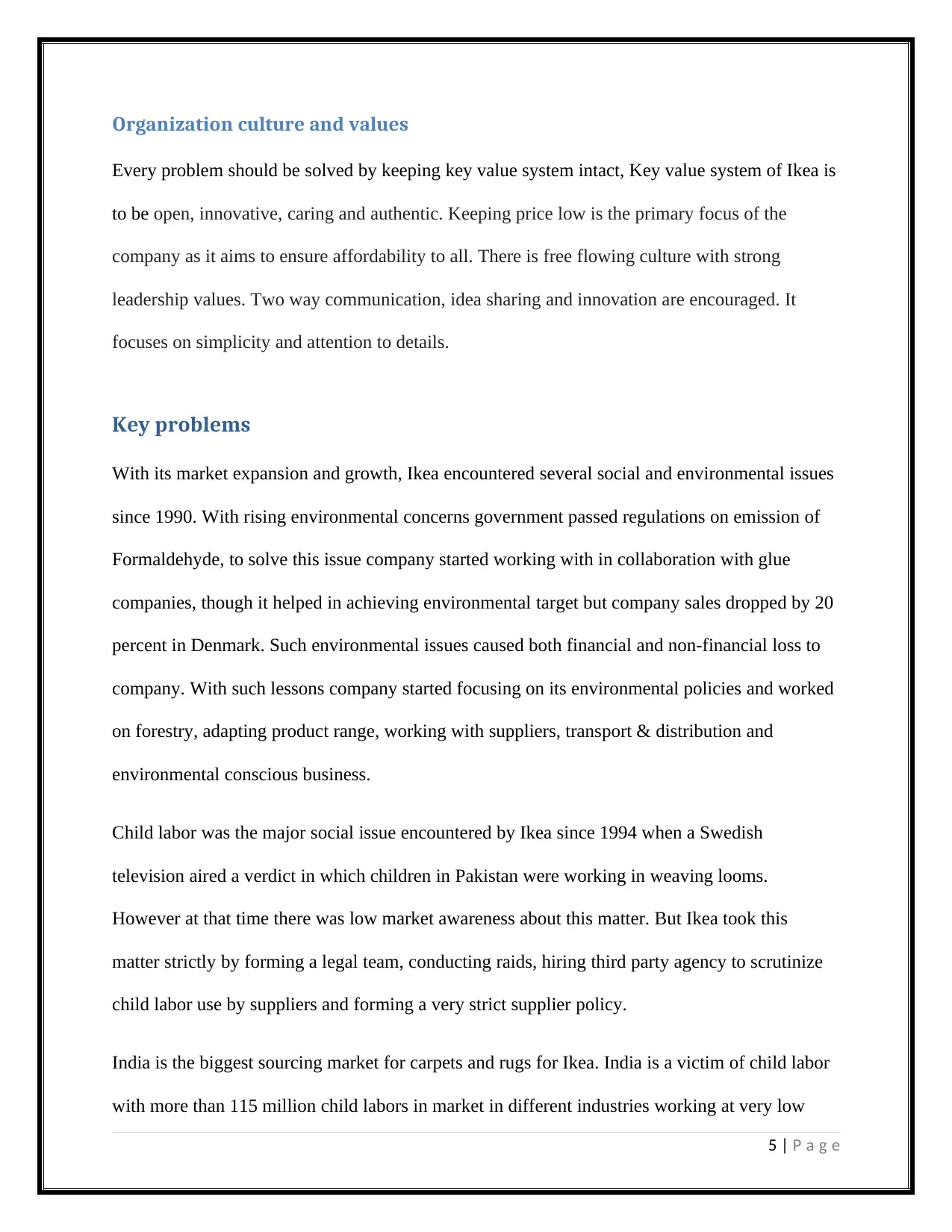
Organization culture and values
Every problem should be solved by keeping key value system intact, Key value system of Ikea is
to be open, innovative, caring and authentic. Keeping price low is the primary focus of the
company as it aims to ensure affordability to all. There is free flowing culture with strong
leadership values. Two way communication, idea sharing and innovation are encouraged. It
focuses on simplicity and attention to details.
Key problems
With its market expansion and growth, Ikea encountered several social and environmental issues
since 1990. With rising environmental concerns government passed regulations on emission of
Formaldehyde, to solve this issue company started working with in collaboration with glue
companies, though it helped in achieving environmental target but company sales dropped by 20
percent in Denmark. Such environmental issues caused both financial and non-financial loss to
company. With such lessons company started focusing on its environmental policies and worked
on forestry, adapting product range, working with suppliers, transport & distribution and
environmental conscious business.
Child labor was the major social issue encountered by Ikea since 1994 when a Swedish
television aired a verdict in which children in Pakistan were working in weaving looms.
However at that time there was low market awareness about this matter. But Ikea took this
matter strictly by forming a legal team, conducting raids, hiring third party agency to scrutinize
child labor use by suppliers and forming a very strict supplier policy.
India is the biggest sourcing market for carpets and rugs for Ikea. India is a victim of child labor
with more than 115 million child labors in market in different industries working at very low
5 | P a g e
Every problem should be solved by keeping key value system intact, Key value system of Ikea is
to be open, innovative, caring and authentic. Keeping price low is the primary focus of the
company as it aims to ensure affordability to all. There is free flowing culture with strong
leadership values. Two way communication, idea sharing and innovation are encouraged. It
focuses on simplicity and attention to details.
Key problems
With its market expansion and growth, Ikea encountered several social and environmental issues
since 1990. With rising environmental concerns government passed regulations on emission of
Formaldehyde, to solve this issue company started working with in collaboration with glue
companies, though it helped in achieving environmental target but company sales dropped by 20
percent in Denmark. Such environmental issues caused both financial and non-financial loss to
company. With such lessons company started focusing on its environmental policies and worked
on forestry, adapting product range, working with suppliers, transport & distribution and
environmental conscious business.
Child labor was the major social issue encountered by Ikea since 1994 when a Swedish
television aired a verdict in which children in Pakistan were working in weaving looms.
However at that time there was low market awareness about this matter. But Ikea took this
matter strictly by forming a legal team, conducting raids, hiring third party agency to scrutinize
child labor use by suppliers and forming a very strict supplier policy.
India is the biggest sourcing market for carpets and rugs for Ikea. India is a victim of child labor
with more than 115 million child labors in market in different industries working at very low
5 | P a g e
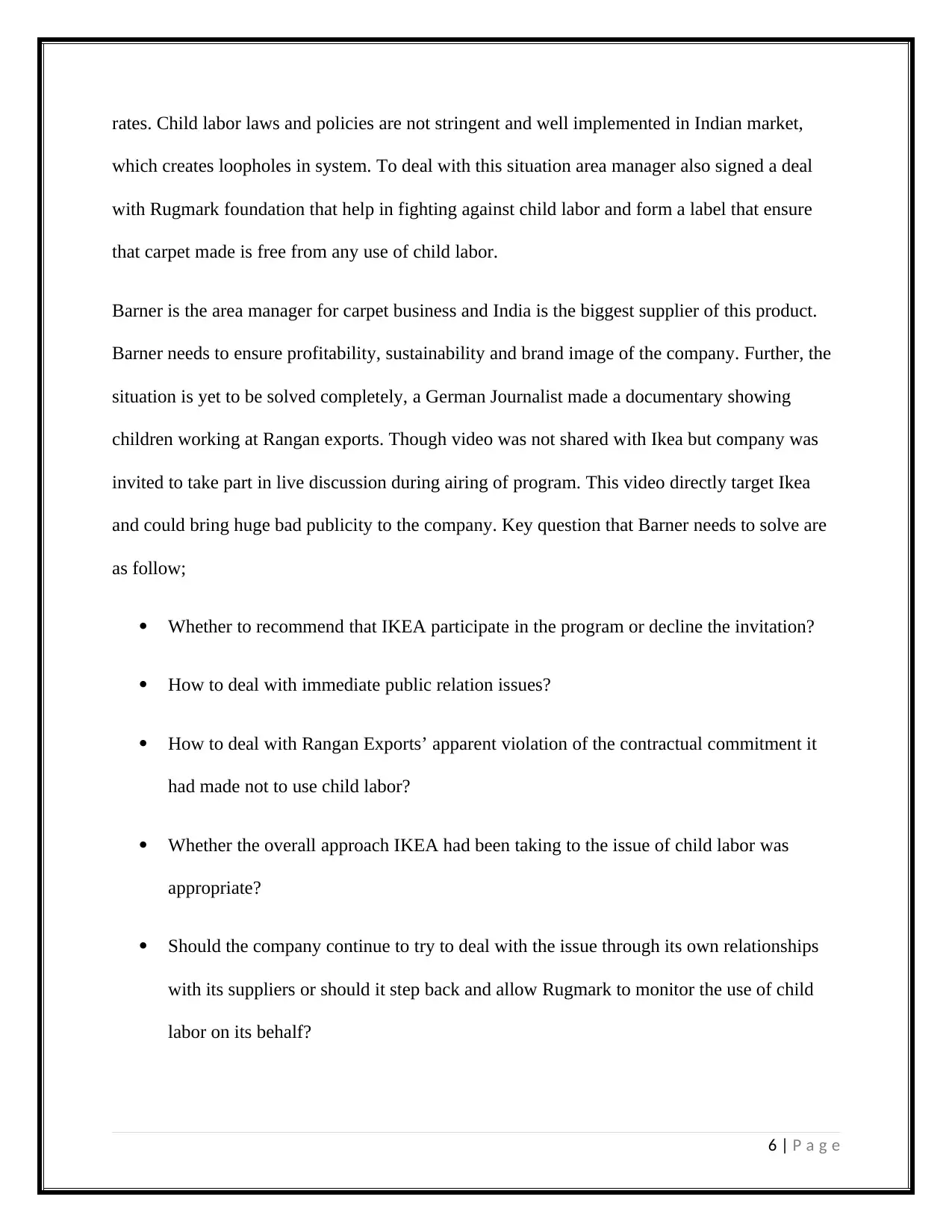
rates. Child labor laws and policies are not stringent and well implemented in Indian market,
which creates loopholes in system. To deal with this situation area manager also signed a deal
with Rugmark foundation that help in fighting against child labor and form a label that ensure
that carpet made is free from any use of child labor.
Barner is the area manager for carpet business and India is the biggest supplier of this product.
Barner needs to ensure profitability, sustainability and brand image of the company. Further, the
situation is yet to be solved completely, a German Journalist made a documentary showing
children working at Rangan exports. Though video was not shared with Ikea but company was
invited to take part in live discussion during airing of program. This video directly target Ikea
and could bring huge bad publicity to the company. Key question that Barner needs to solve are
as follow;
Whether to recommend that IKEA participate in the program or decline the invitation?
How to deal with immediate public relation issues?
How to deal with Rangan Exports’ apparent violation of the contractual commitment it
had made not to use child labor?
Whether the overall approach IKEA had been taking to the issue of child labor was
appropriate?
Should the company continue to try to deal with the issue through its own relationships
with its suppliers or should it step back and allow Rugmark to monitor the use of child
labor on its behalf?
6 | P a g e
which creates loopholes in system. To deal with this situation area manager also signed a deal
with Rugmark foundation that help in fighting against child labor and form a label that ensure
that carpet made is free from any use of child labor.
Barner is the area manager for carpet business and India is the biggest supplier of this product.
Barner needs to ensure profitability, sustainability and brand image of the company. Further, the
situation is yet to be solved completely, a German Journalist made a documentary showing
children working at Rangan exports. Though video was not shared with Ikea but company was
invited to take part in live discussion during airing of program. This video directly target Ikea
and could bring huge bad publicity to the company. Key question that Barner needs to solve are
as follow;
Whether to recommend that IKEA participate in the program or decline the invitation?
How to deal with immediate public relation issues?
How to deal with Rangan Exports’ apparent violation of the contractual commitment it
had made not to use child labor?
Whether the overall approach IKEA had been taking to the issue of child labor was
appropriate?
Should the company continue to try to deal with the issue through its own relationships
with its suppliers or should it step back and allow Rugmark to monitor the use of child
labor on its behalf?
6 | P a g e
⊘ This is a preview!⊘
Do you want full access?
Subscribe today to unlock all pages.

Trusted by 1+ million students worldwide
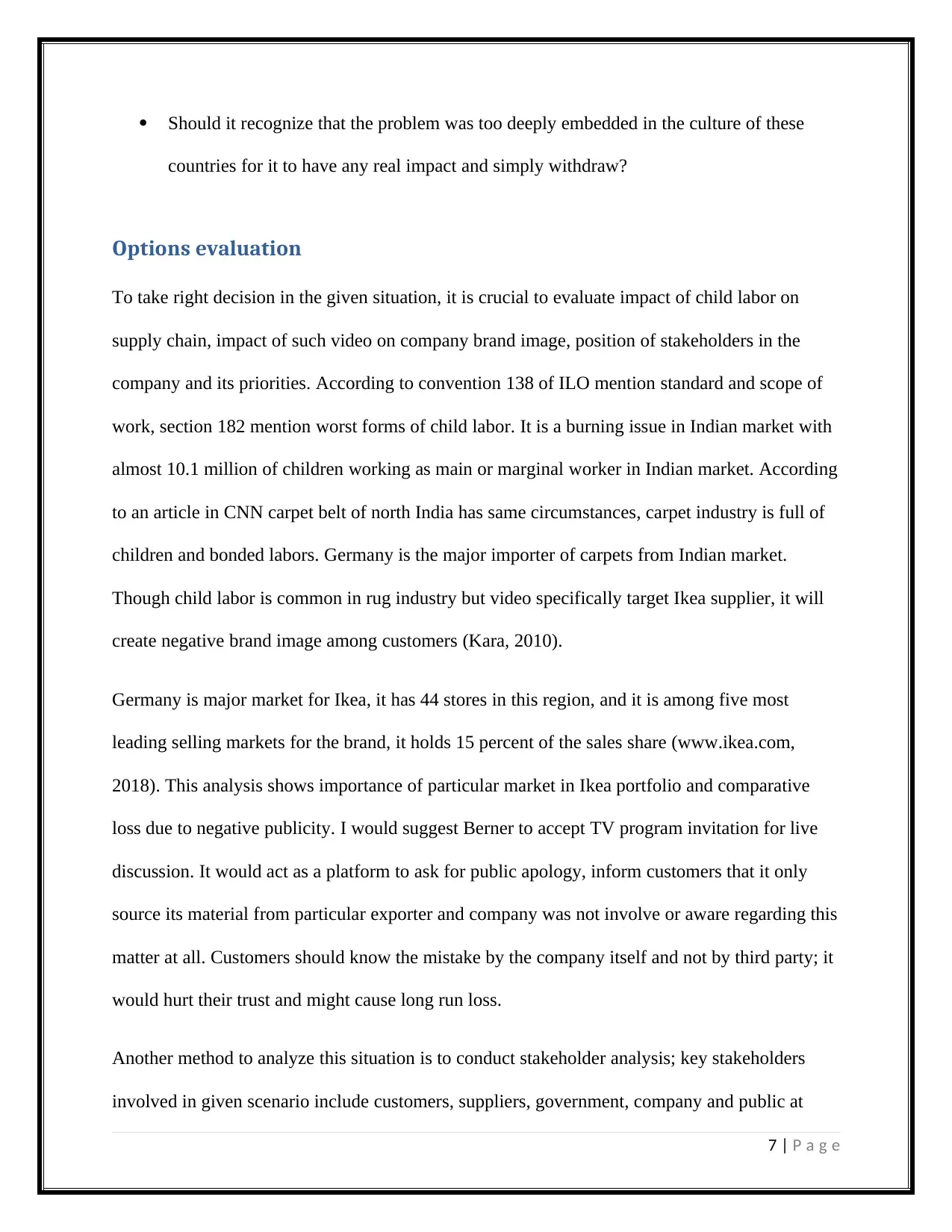
Should it recognize that the problem was too deeply embedded in the culture of these
countries for it to have any real impact and simply withdraw?
Options evaluation
To take right decision in the given situation, it is crucial to evaluate impact of child labor on
supply chain, impact of such video on company brand image, position of stakeholders in the
company and its priorities. According to convention 138 of ILO mention standard and scope of
work, section 182 mention worst forms of child labor. It is a burning issue in Indian market with
almost 10.1 million of children working as main or marginal worker in Indian market. According
to an article in CNN carpet belt of north India has same circumstances, carpet industry is full of
children and bonded labors. Germany is the major importer of carpets from Indian market.
Though child labor is common in rug industry but video specifically target Ikea supplier, it will
create negative brand image among customers (Kara, 2010).
Germany is major market for Ikea, it has 44 stores in this region, and it is among five most
leading selling markets for the brand, it holds 15 percent of the sales share (www.ikea.com,
2018). This analysis shows importance of particular market in Ikea portfolio and comparative
loss due to negative publicity. I would suggest Berner to accept TV program invitation for live
discussion. It would act as a platform to ask for public apology, inform customers that it only
source its material from particular exporter and company was not involve or aware regarding this
matter at all. Customers should know the mistake by the company itself and not by third party; it
would hurt their trust and might cause long run loss.
Another method to analyze this situation is to conduct stakeholder analysis; key stakeholders
involved in given scenario include customers, suppliers, government, company and public at
7 | P a g e
countries for it to have any real impact and simply withdraw?
Options evaluation
To take right decision in the given situation, it is crucial to evaluate impact of child labor on
supply chain, impact of such video on company brand image, position of stakeholders in the
company and its priorities. According to convention 138 of ILO mention standard and scope of
work, section 182 mention worst forms of child labor. It is a burning issue in Indian market with
almost 10.1 million of children working as main or marginal worker in Indian market. According
to an article in CNN carpet belt of north India has same circumstances, carpet industry is full of
children and bonded labors. Germany is the major importer of carpets from Indian market.
Though child labor is common in rug industry but video specifically target Ikea supplier, it will
create negative brand image among customers (Kara, 2010).
Germany is major market for Ikea, it has 44 stores in this region, and it is among five most
leading selling markets for the brand, it holds 15 percent of the sales share (www.ikea.com,
2018). This analysis shows importance of particular market in Ikea portfolio and comparative
loss due to negative publicity. I would suggest Berner to accept TV program invitation for live
discussion. It would act as a platform to ask for public apology, inform customers that it only
source its material from particular exporter and company was not involve or aware regarding this
matter at all. Customers should know the mistake by the company itself and not by third party; it
would hurt their trust and might cause long run loss.
Another method to analyze this situation is to conduct stakeholder analysis; key stakeholders
involved in given scenario include customers, suppliers, government, company and public at
7 | P a g e
Paraphrase This Document
Need a fresh take? Get an instant paraphrase of this document with our AI Paraphraser
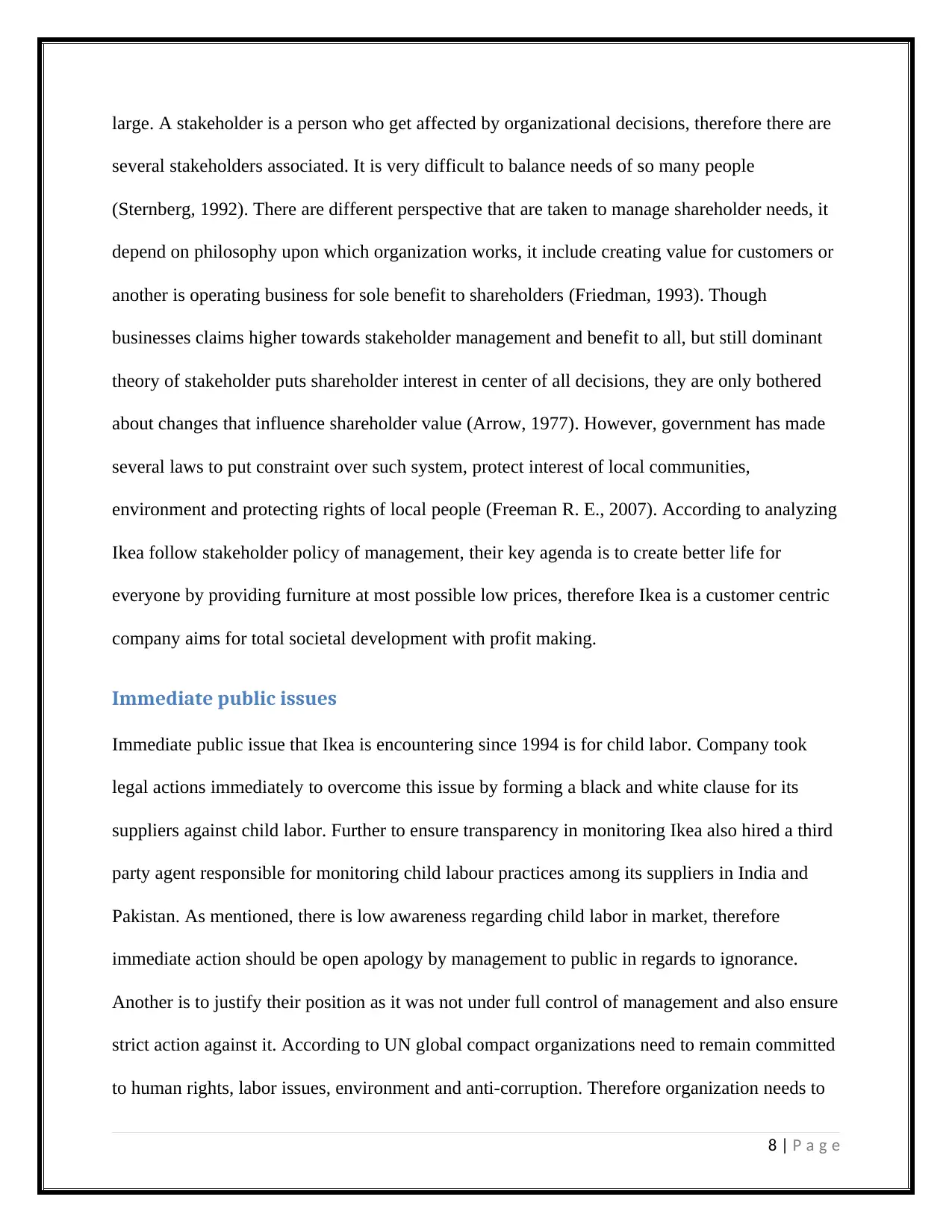
large. A stakeholder is a person who get affected by organizational decisions, therefore there are
several stakeholders associated. It is very difficult to balance needs of so many people
(Sternberg, 1992). There are different perspective that are taken to manage shareholder needs, it
depend on philosophy upon which organization works, it include creating value for customers or
another is operating business for sole benefit to shareholders (Friedman, 1993). Though
businesses claims higher towards stakeholder management and benefit to all, but still dominant
theory of stakeholder puts shareholder interest in center of all decisions, they are only bothered
about changes that influence shareholder value (Arrow, 1977). However, government has made
several laws to put constraint over such system, protect interest of local communities,
environment and protecting rights of local people (Freeman R. E., 2007). According to analyzing
Ikea follow stakeholder policy of management, their key agenda is to create better life for
everyone by providing furniture at most possible low prices, therefore Ikea is a customer centric
company aims for total societal development with profit making.
Immediate public issues
Immediate public issue that Ikea is encountering since 1994 is for child labor. Company took
legal actions immediately to overcome this issue by forming a black and white clause for its
suppliers against child labor. Further to ensure transparency in monitoring Ikea also hired a third
party agent responsible for monitoring child labour practices among its suppliers in India and
Pakistan. As mentioned, there is low awareness regarding child labor in market, therefore
immediate action should be open apology by management to public in regards to ignorance.
Another is to justify their position as it was not under full control of management and also ensure
strict action against it. According to UN global compact organizations need to remain committed
to human rights, labor issues, environment and anti-corruption. Therefore organization needs to
8 | P a g e
several stakeholders associated. It is very difficult to balance needs of so many people
(Sternberg, 1992). There are different perspective that are taken to manage shareholder needs, it
depend on philosophy upon which organization works, it include creating value for customers or
another is operating business for sole benefit to shareholders (Friedman, 1993). Though
businesses claims higher towards stakeholder management and benefit to all, but still dominant
theory of stakeholder puts shareholder interest in center of all decisions, they are only bothered
about changes that influence shareholder value (Arrow, 1977). However, government has made
several laws to put constraint over such system, protect interest of local communities,
environment and protecting rights of local people (Freeman R. E., 2007). According to analyzing
Ikea follow stakeholder policy of management, their key agenda is to create better life for
everyone by providing furniture at most possible low prices, therefore Ikea is a customer centric
company aims for total societal development with profit making.
Immediate public issues
Immediate public issue that Ikea is encountering since 1994 is for child labor. Company took
legal actions immediately to overcome this issue by forming a black and white clause for its
suppliers against child labor. Further to ensure transparency in monitoring Ikea also hired a third
party agent responsible for monitoring child labour practices among its suppliers in India and
Pakistan. As mentioned, there is low awareness regarding child labor in market, therefore
immediate action should be open apology by management to public in regards to ignorance.
Another is to justify their position as it was not under full control of management and also ensure
strict action against it. According to UN global compact organizations need to remain committed
to human rights, labor issues, environment and anti-corruption. Therefore organization needs to
8 | P a g e

develop responsible strategies to ensure long term viability by balancing both economic and
social needs (Bartlett & Beamish, 2018).
Dealing with Rangan export
As the company has strict supplier contract that clearly states that use of child labor will cause
immediate cancellation of contract. Rangan was major supplier for Ikea, removing it from the list
will cause huge business and financial loss to company and keeping it might attract bad
publicity. This issue needs consideration on three key elements responsibility, supply chain and
supply chain governance. According to Seuring and Muller (2008) focal company, the one which
rule the supply chain could be held responsible for performance of their suppliers in terms of
social and environmental parameters; as these companies are the one who design supply chain,
provide direct contact with customers. Adequate governance of supply chain system requires
proper clarity on management and rules, adequate communication with suppliers, auditing, and
controlling information (Arrow, 1977). Company needs to opt for a systematic and preventive
risk management strategy to address such scenario in future (Carroll, 1991).
Therefore, I would suggest that Barner should hire independent auditor to scrutinize Rangan
export case, further like earlier there can be unannounced raids to Rangan export by Barner and
team to see reality. If violation is provided then Rangan export contract must be halted as it will
facilitate in sending strong message to whole market and other suppliers regarding child labor
rules. Further, legal action and penalty must be imposed on Rangan export; all children must be
freed and sent back to their homes.
9 | P a g e
social needs (Bartlett & Beamish, 2018).
Dealing with Rangan export
As the company has strict supplier contract that clearly states that use of child labor will cause
immediate cancellation of contract. Rangan was major supplier for Ikea, removing it from the list
will cause huge business and financial loss to company and keeping it might attract bad
publicity. This issue needs consideration on three key elements responsibility, supply chain and
supply chain governance. According to Seuring and Muller (2008) focal company, the one which
rule the supply chain could be held responsible for performance of their suppliers in terms of
social and environmental parameters; as these companies are the one who design supply chain,
provide direct contact with customers. Adequate governance of supply chain system requires
proper clarity on management and rules, adequate communication with suppliers, auditing, and
controlling information (Arrow, 1977). Company needs to opt for a systematic and preventive
risk management strategy to address such scenario in future (Carroll, 1991).
Therefore, I would suggest that Barner should hire independent auditor to scrutinize Rangan
export case, further like earlier there can be unannounced raids to Rangan export by Barner and
team to see reality. If violation is provided then Rangan export contract must be halted as it will
facilitate in sending strong message to whole market and other suppliers regarding child labor
rules. Further, legal action and penalty must be imposed on Rangan export; all children must be
freed and sent back to their homes.
9 | P a g e
⊘ This is a preview!⊘
Do you want full access?
Subscribe today to unlock all pages.

Trusted by 1+ million students worldwide
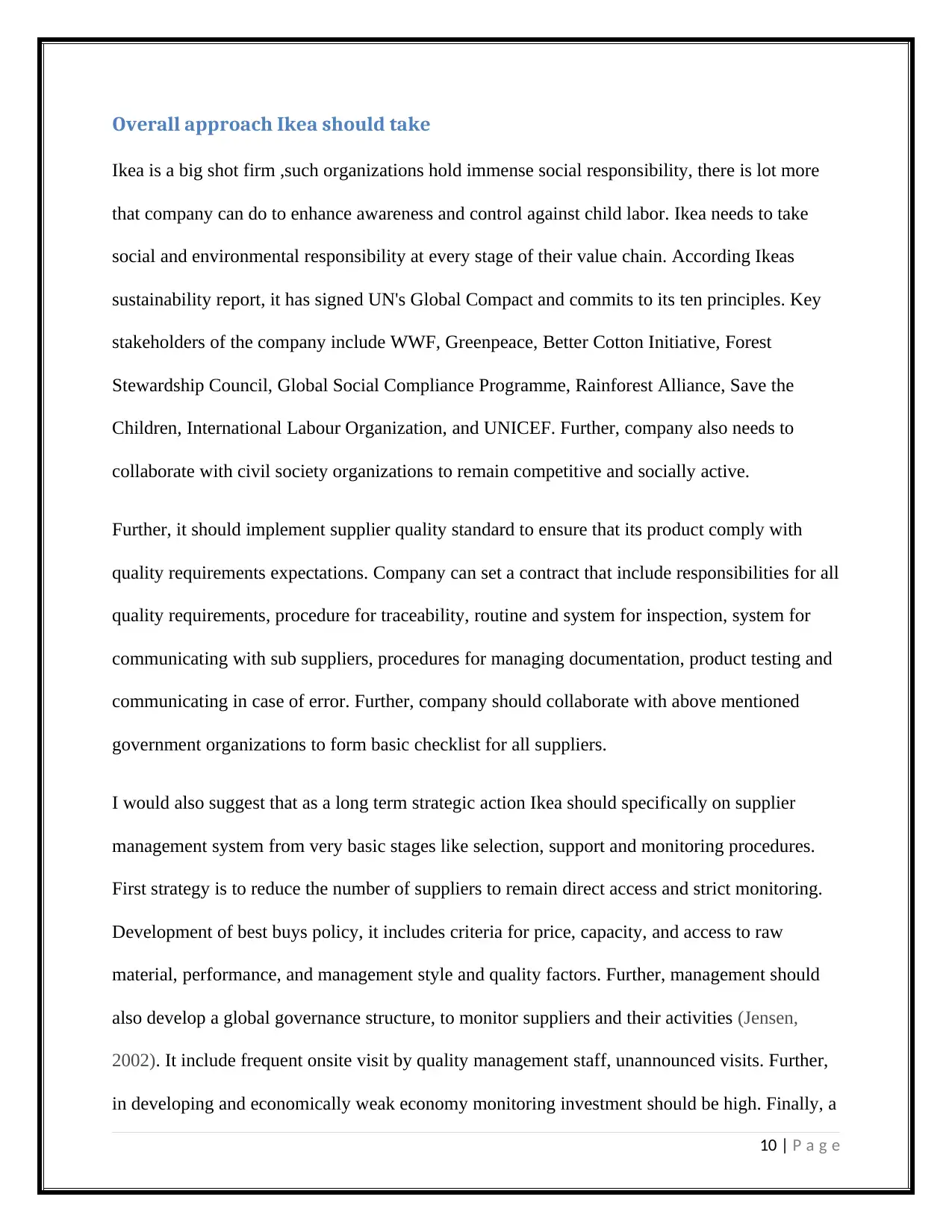
Overall approach Ikea should take
Ikea is a big shot firm ,such organizations hold immense social responsibility, there is lot more
that company can do to enhance awareness and control against child labor. Ikea needs to take
social and environmental responsibility at every stage of their value chain. According Ikeas
sustainability report, it has signed UN's Global Compact and commits to its ten principles. Key
stakeholders of the company include WWF, Greenpeace, Better Cotton Initiative, Forest
Stewardship Council, Global Social Compliance Programme, Rainforest Alliance, Save the
Children, International Labour Organization, and UNICEF. Further, company also needs to
collaborate with civil society organizations to remain competitive and socially active.
Further, it should implement supplier quality standard to ensure that its product comply with
quality requirements expectations. Company can set a contract that include responsibilities for all
quality requirements, procedure for traceability, routine and system for inspection, system for
communicating with sub suppliers, procedures for managing documentation, product testing and
communicating in case of error. Further, company should collaborate with above mentioned
government organizations to form basic checklist for all suppliers.
I would also suggest that as a long term strategic action Ikea should specifically on supplier
management system from very basic stages like selection, support and monitoring procedures.
First strategy is to reduce the number of suppliers to remain direct access and strict monitoring.
Development of best buys policy, it includes criteria for price, capacity, and access to raw
material, performance, and management style and quality factors. Further, management should
also develop a global governance structure, to monitor suppliers and their activities (Jensen,
2002). It include frequent onsite visit by quality management staff, unannounced visits. Further,
in developing and economically weak economy monitoring investment should be high. Finally, a
10 | P a g e
Ikea is a big shot firm ,such organizations hold immense social responsibility, there is lot more
that company can do to enhance awareness and control against child labor. Ikea needs to take
social and environmental responsibility at every stage of their value chain. According Ikeas
sustainability report, it has signed UN's Global Compact and commits to its ten principles. Key
stakeholders of the company include WWF, Greenpeace, Better Cotton Initiative, Forest
Stewardship Council, Global Social Compliance Programme, Rainforest Alliance, Save the
Children, International Labour Organization, and UNICEF. Further, company also needs to
collaborate with civil society organizations to remain competitive and socially active.
Further, it should implement supplier quality standard to ensure that its product comply with
quality requirements expectations. Company can set a contract that include responsibilities for all
quality requirements, procedure for traceability, routine and system for inspection, system for
communicating with sub suppliers, procedures for managing documentation, product testing and
communicating in case of error. Further, company should collaborate with above mentioned
government organizations to form basic checklist for all suppliers.
I would also suggest that as a long term strategic action Ikea should specifically on supplier
management system from very basic stages like selection, support and monitoring procedures.
First strategy is to reduce the number of suppliers to remain direct access and strict monitoring.
Development of best buys policy, it includes criteria for price, capacity, and access to raw
material, performance, and management style and quality factors. Further, management should
also develop a global governance structure, to monitor suppliers and their activities (Jensen,
2002). It include frequent onsite visit by quality management staff, unannounced visits. Further,
in developing and economically weak economy monitoring investment should be high. Finally, a
10 | P a g e
Paraphrase This Document
Need a fresh take? Get an instant paraphrase of this document with our AI Paraphraser
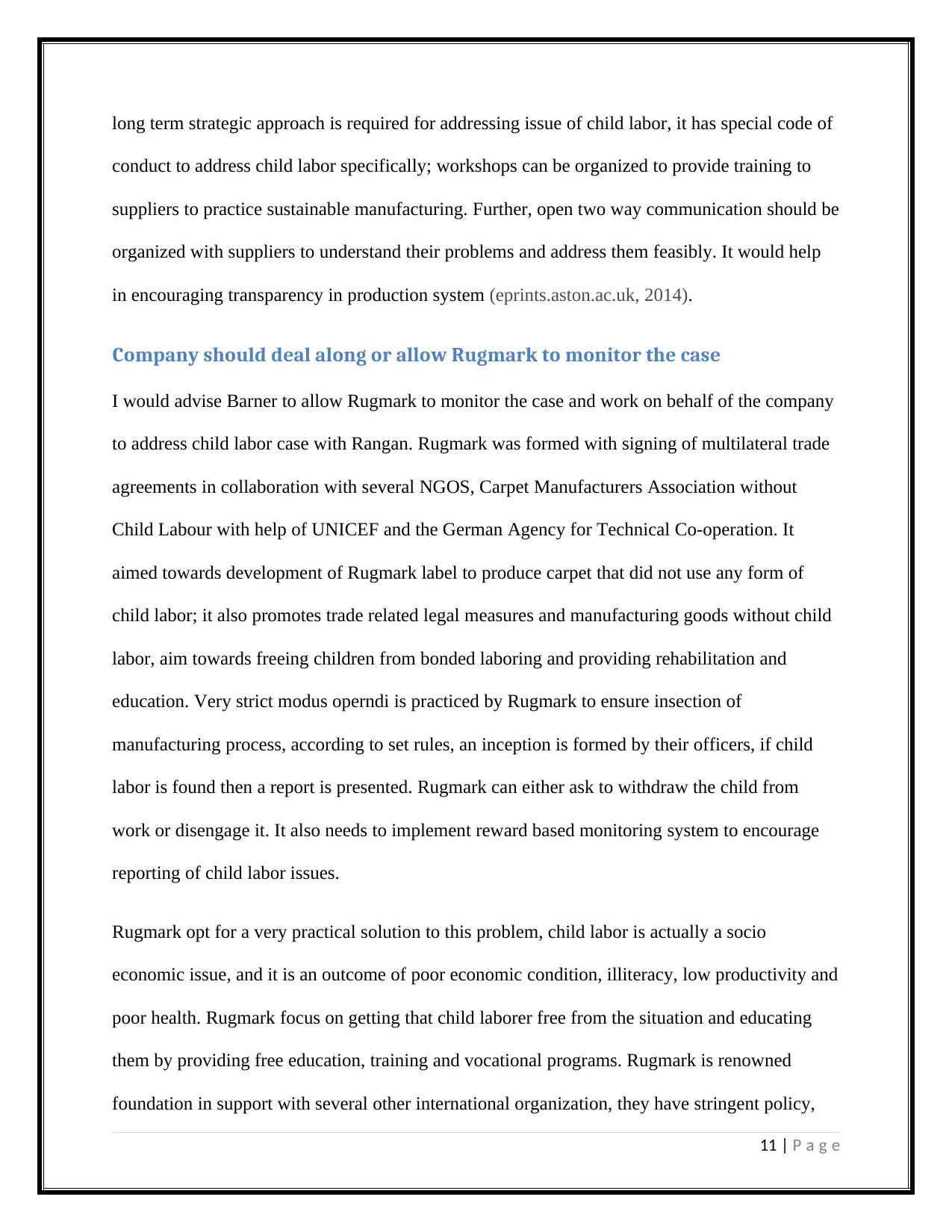
long term strategic approach is required for addressing issue of child labor, it has special code of
conduct to address child labor specifically; workshops can be organized to provide training to
suppliers to practice sustainable manufacturing. Further, open two way communication should be
organized with suppliers to understand their problems and address them feasibly. It would help
in encouraging transparency in production system (eprints.aston.ac.uk, 2014).
Company should deal along or allow Rugmark to monitor the case
I would advise Barner to allow Rugmark to monitor the case and work on behalf of the company
to address child labor case with Rangan. Rugmark was formed with signing of multilateral trade
agreements in collaboration with several NGOS, Carpet Manufacturers Association without
Child Labour with help of UNICEF and the German Agency for Technical Co-operation. It
aimed towards development of Rugmark label to produce carpet that did not use any form of
child labor; it also promotes trade related legal measures and manufacturing goods without child
labor, aim towards freeing children from bonded laboring and providing rehabilitation and
education. Very strict modus operndi is practiced by Rugmark to ensure insection of
manufacturing process, according to set rules, an inception is formed by their officers, if child
labor is found then a report is presented. Rugmark can either ask to withdraw the child from
work or disengage it. It also needs to implement reward based monitoring system to encourage
reporting of child labor issues.
Rugmark opt for a very practical solution to this problem, child labor is actually a socio
economic issue, and it is an outcome of poor economic condition, illiteracy, low productivity and
poor health. Rugmark focus on getting that child laborer free from the situation and educating
them by providing free education, training and vocational programs. Rugmark is renowned
foundation in support with several other international organization, they have stringent policy,
11 | P a g e
conduct to address child labor specifically; workshops can be organized to provide training to
suppliers to practice sustainable manufacturing. Further, open two way communication should be
organized with suppliers to understand their problems and address them feasibly. It would help
in encouraging transparency in production system (eprints.aston.ac.uk, 2014).
Company should deal along or allow Rugmark to monitor the case
I would advise Barner to allow Rugmark to monitor the case and work on behalf of the company
to address child labor case with Rangan. Rugmark was formed with signing of multilateral trade
agreements in collaboration with several NGOS, Carpet Manufacturers Association without
Child Labour with help of UNICEF and the German Agency for Technical Co-operation. It
aimed towards development of Rugmark label to produce carpet that did not use any form of
child labor; it also promotes trade related legal measures and manufacturing goods without child
labor, aim towards freeing children from bonded laboring and providing rehabilitation and
education. Very strict modus operndi is practiced by Rugmark to ensure insection of
manufacturing process, according to set rules, an inception is formed by their officers, if child
labor is found then a report is presented. Rugmark can either ask to withdraw the child from
work or disengage it. It also needs to implement reward based monitoring system to encourage
reporting of child labor issues.
Rugmark opt for a very practical solution to this problem, child labor is actually a socio
economic issue, and it is an outcome of poor economic condition, illiteracy, low productivity and
poor health. Rugmark focus on getting that child laborer free from the situation and educating
them by providing free education, training and vocational programs. Rugmark is renowned
foundation in support with several other international organization, they have stringent policy,
11 | P a g e
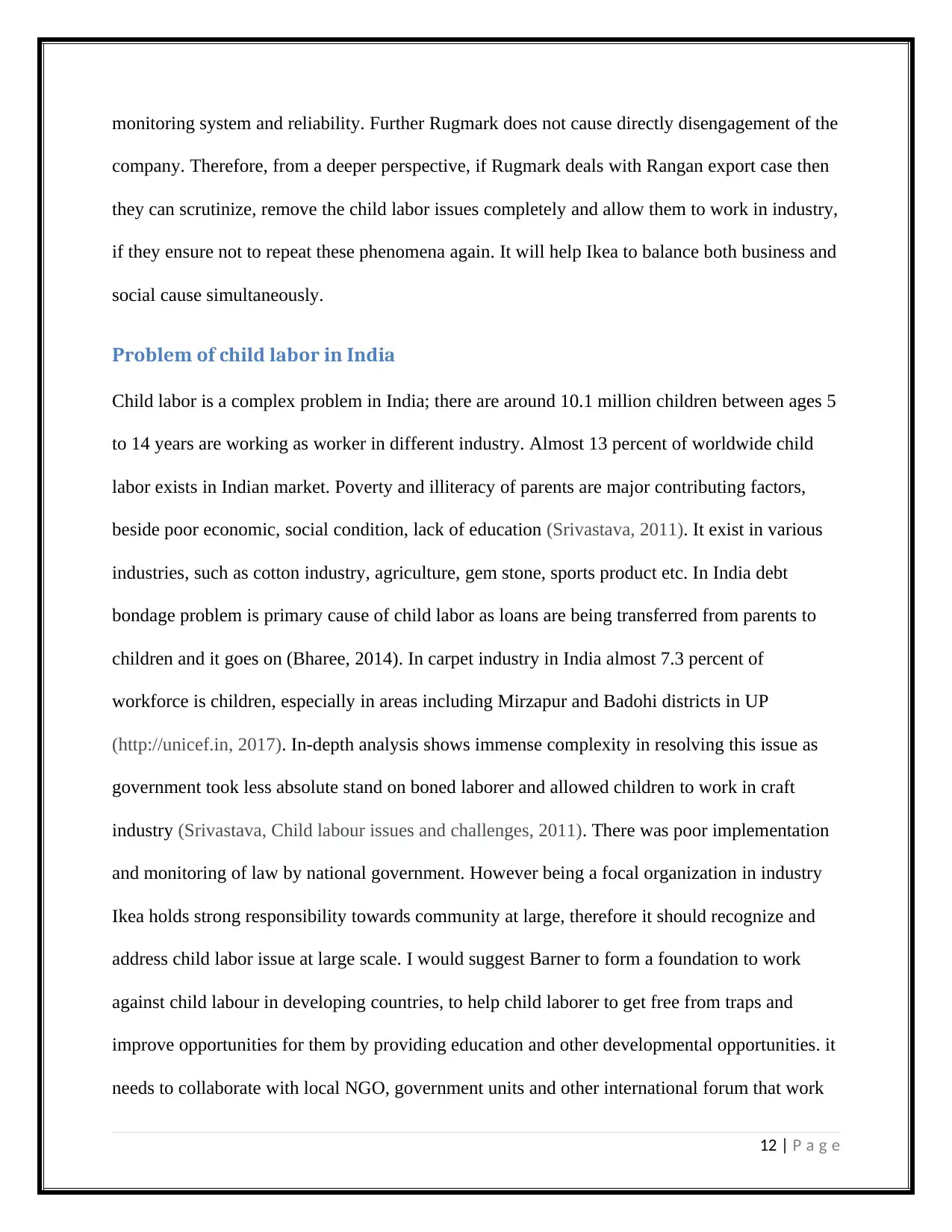
monitoring system and reliability. Further Rugmark does not cause directly disengagement of the
company. Therefore, from a deeper perspective, if Rugmark deals with Rangan export case then
they can scrutinize, remove the child labor issues completely and allow them to work in industry,
if they ensure not to repeat these phenomena again. It will help Ikea to balance both business and
social cause simultaneously.
Problem of child labor in India
Child labor is a complex problem in India; there are around 10.1 million children between ages 5
to 14 years are working as worker in different industry. Almost 13 percent of worldwide child
labor exists in Indian market. Poverty and illiteracy of parents are major contributing factors,
beside poor economic, social condition, lack of education (Srivastava, 2011). It exist in various
industries, such as cotton industry, agriculture, gem stone, sports product etc. In India debt
bondage problem is primary cause of child labor as loans are being transferred from parents to
children and it goes on (Bharee, 2014). In carpet industry in India almost 7.3 percent of
workforce is children, especially in areas including Mirzapur and Badohi districts in UP
(http://unicef.in, 2017). In-depth analysis shows immense complexity in resolving this issue as
government took less absolute stand on boned laborer and allowed children to work in craft
industry (Srivastava, Child labour issues and challenges, 2011). There was poor implementation
and monitoring of law by national government. However being a focal organization in industry
Ikea holds strong responsibility towards community at large, therefore it should recognize and
address child labor issue at large scale. I would suggest Barner to form a foundation to work
against child labour in developing countries, to help child laborer to get free from traps and
improve opportunities for them by providing education and other developmental opportunities. it
needs to collaborate with local NGO, government units and other international forum that work
12 | P a g e
company. Therefore, from a deeper perspective, if Rugmark deals with Rangan export case then
they can scrutinize, remove the child labor issues completely and allow them to work in industry,
if they ensure not to repeat these phenomena again. It will help Ikea to balance both business and
social cause simultaneously.
Problem of child labor in India
Child labor is a complex problem in India; there are around 10.1 million children between ages 5
to 14 years are working as worker in different industry. Almost 13 percent of worldwide child
labor exists in Indian market. Poverty and illiteracy of parents are major contributing factors,
beside poor economic, social condition, lack of education (Srivastava, 2011). It exist in various
industries, such as cotton industry, agriculture, gem stone, sports product etc. In India debt
bondage problem is primary cause of child labor as loans are being transferred from parents to
children and it goes on (Bharee, 2014). In carpet industry in India almost 7.3 percent of
workforce is children, especially in areas including Mirzapur and Badohi districts in UP
(http://unicef.in, 2017). In-depth analysis shows immense complexity in resolving this issue as
government took less absolute stand on boned laborer and allowed children to work in craft
industry (Srivastava, Child labour issues and challenges, 2011). There was poor implementation
and monitoring of law by national government. However being a focal organization in industry
Ikea holds strong responsibility towards community at large, therefore it should recognize and
address child labor issue at large scale. I would suggest Barner to form a foundation to work
against child labour in developing countries, to help child laborer to get free from traps and
improve opportunities for them by providing education and other developmental opportunities. it
needs to collaborate with local NGO, government units and other international forum that work
12 | P a g e
⊘ This is a preview!⊘
Do you want full access?
Subscribe today to unlock all pages.

Trusted by 1+ million students worldwide
1 out of 17
Related Documents
Your All-in-One AI-Powered Toolkit for Academic Success.
+13062052269
info@desklib.com
Available 24*7 on WhatsApp / Email
![[object Object]](/_next/static/media/star-bottom.7253800d.svg)
Unlock your academic potential
Copyright © 2020–2026 A2Z Services. All Rights Reserved. Developed and managed by ZUCOL.





